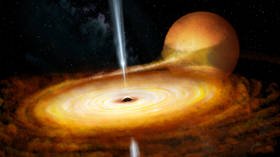Black hole caught flickering violently WITHIN our galaxy

A black hole located within Earth’s Milky Way galaxy is voraciously consuming its neighboring star with such ferocity that it is literally flickering with visible light, in what is perhaps the cosmic equivalent of drooling.
The black hole, named MAXI J1820+070, is located roughly 10,000 light years away and is roughly seven times the mass of the Sun (the lowest estimated mass for a black hole is about five Suns).
Amazingly, researchers managed to capture the star twinkling by using a new high frame-rate technique, which affords a rate of over 300 frames per second. They were able to capture the fascinating data thanks to the HiPERCAM instrument on the Gran Telescopio Canarias and in X-rays by NASA's NICER observatory on the International Space Station.
They could then recreate the stunning phenomenon in video form using the latest modeling software.
“The movie was made using real data, but slowed down to one tenth of actual speed, to allow the most rapid flares to be discerned by the human eye,” astronomer John Paice, of the University of Southampton and the Inter-University Centre for Astronomy & Astrophysics, explained.
As MAXI consumes the nearby star, the black hole is emitting not just a cacophony of x-rays but also visible light radiation, which literally caught the eye of astronomers.
Also on rt.com Astronomers discover most MASSIVE neutron star known to manThe material around the black hole is incredibly bright, with a light output of roughly one hundred suns, because it has been crushed and compressed by a combination of friction, magnetic and gravitational forces.
Because of this, the researchers think it may hint at a unifying characteristic of such black holes that might explain just how plasma is produced and maintained in space, a feat which has proven next to impossible for any meaningful amount of time here on Earth.
Like this story? Share it with a friend!












